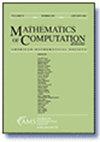稀疏跟踪测试
IF 2.1
2区 数学
Q1 MATHEMATICS, APPLIED
引用次数: 1
摘要
我们建立了一个稀疏多项式系统的系数如何影响其零的和(或迹)。作为应用,我们开发了验证稀疏系统的一组解是否完备的数值测试。这些算法扩展了数值代数几何中的经典迹检验。我们的结果既依赖于对稀疏结果结构的分析,也依赖于对Esterov在稀疏系统单群上的结果的推广。本文章由计算机程序翻译,如有差异,请以英文原文为准。
Sparse trace tests
We establish how the coefficients of a sparse polynomial system influence the sum (or the trace) of its zeros. As an application, we develop numerical tests for verifying whether a set of solutions to a sparse system is complete. These algorithms extend the classical trace test in numerical algebraic geometry. Our results rely on both the analysis of the structure of sparse resultants as well as an extension of Esterov’s results on monodromy groups of sparse systems.
求助全文
通过发布文献求助,成功后即可免费获取论文全文。
去求助
来源期刊

Mathematics of Computation
数学-应用数学
CiteScore
3.90
自引率
5.00%
发文量
55
审稿时长
7.0 months
期刊介绍:
All articles submitted to this journal are peer-reviewed. The AMS has a single blind peer-review process in which the reviewers know who the authors of the manuscript are, but the authors do not have access to the information on who the peer reviewers are.
This journal is devoted to research articles of the highest quality in computational mathematics. Areas covered include numerical analysis, computational discrete mathematics, including number theory, algebra and combinatorics, and related fields such as stochastic numerical methods. Articles must be of significant computational interest and contain original and substantial mathematical analysis or development of computational methodology.
 求助内容:
求助内容: 应助结果提醒方式:
应助结果提醒方式:


